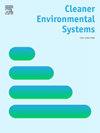探索covid - 19、能源危机和住宅供暖PM2.5排放之间的联系
IF 4.9
Q2 ENGINEERING, ENVIRONMENTAL
引用次数: 0
摘要
地缘政治事件已显示出对2022年欧洲能源安全的威胁。在习惯于低能源价格的挪威,2022年南部的电价是长期平均水平的4倍,而北部的能源价格保持稳定。这为研究价格对家庭能源消耗和住宅部门PM2.5排放的影响提供了一个机会。在南方,用电量下降了10%,而在北方,用电量相对于预期值保持不变。虽然增加的电价和减少的能耗之间的相关文献已经确立,但我们的研究独特地捕捉到了向木材作为替代能源的重大转变。在南方,用于取暖的木材增加了大约40%,有效地替代了节省的一半电力。尽管政府对电力的大力补贴抑制了价格,但这一增长还是发生了。面对欧洲更高的能源成本,我们模拟了一个场景,即欧洲各地的消费者都在寻找负担得起的能源。预计到2030年,天然气和电力价格将远高于长期平均水平,生物质将是一个有吸引力的选择。我们的研究表明,这种转变如何危及欧洲的零污染战略,以及针对减少住宅生物质供暖的举措的必要性。本文章由计算机程序翻译,如有差异,请以英文原文为准。

Exploring the connection between COVID19, the energy crisis and PM2.5 emissions from residential heating
Geopolitical events have shown to threaten European energy security in 2022. In Norway, accustomed to low energy prices, the southern part saw 4 times higher electricity prices in 2022 than long term average, whereas in the north, energy prices remained stable. This offers an opportunity to examine the effect of price on household energy consumption and PM2.5 emissions from the residential sector. In the south, electricity consumption went down by 10% while in the north it remained unchanged relative to expected values. While the documented correlation between increased electricity prices and reduced consumption is well-established, our study uniquely captures a substantial shift towards wood as an alternative energy source. In the south, wood for heating increased by approximately 40%, effectively replacing half of the electricity saved. This increase happened despite prices being curbed by strong government subsidies on electricity. Faced with higher energy costs in Europe, we simulate a scenario where consumers across Europe look for affordable energy. With gas and electricity prices predicted to remain well above long-term averages until 2030, biomass will be an attractive option. Our study shows how a shift can endanger Europe's Zero-Pollution strategy, and the need for initiatives targeting the reduction of residential biomass heating.
求助全文
通过发布文献求助,成功后即可免费获取论文全文。
去求助
来源期刊

Cleaner Environmental Systems
Environmental Science-Environmental Science (miscellaneous)
CiteScore
7.80
自引率
0.00%
发文量
32
审稿时长
52 days
 求助内容:
求助内容: 应助结果提醒方式:
应助结果提醒方式:


